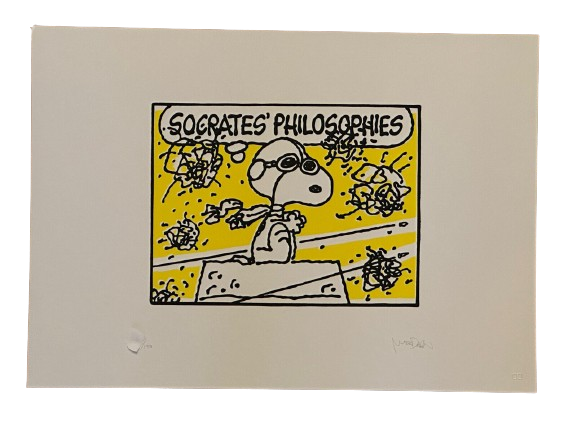
TV Television

Mark Drew Socrates Philosophies Wu-Tang Clan Silkscreen Print by Mark Drew
Socrates' Philosophies Wu-Tang Clan Silkscreen Print by Mark Drew Hand-Pulled on Fine Art Paper Limited Edition Artwork. 2021 Signed & Numbered Limited Edition of 150 Artwork Size 16.5x11.73 Silkscreen Print Mark Drew's Blend of Classical Thought and Modern Rhythms Mark Drew's silkscreen print titled "Socrates' Philosophies Wu-Tang Clan" represents a unique intersection of classical philosophy and contemporary hip-hop, embodied within the medium of Street Pop Art and Graffiti Artwork. The limited edition piece, hand-pulled on fine art paper, was released in 2021 in a numbered series of 150, each piece bearing the artist's signature. The artwork, measuring 16.5x11.73 inches, features a silkscreen print that stands out for its creative fusion of an iconic historical figure with the lyrical genius of the Wu-Tang Clan, a seminal group in the landscape of hip-hop music. The print alludes to a famous line from the Wu-Tang Clan's "Wu-Tang Forever" album, where rap is elevated to the status of philosophical discourse. Drew's artistic rendition captures the essence of this comparison by depicting a cartoon character in deep contemplation, surrounded by the chaos of flying bees, symbolizing the swarming ideas of Socrates' philosophies with the swarm of the Wu-Tang Clan's collective creativity. This work celebrates the enduring relevance of philosophical inquiry, cleverly juxtaposed with the enduring impact of hip-hop on modern culture. The Cultural Commentary of Drew's Artistic Expression The cultural commentary in "Socrates' Philosophies Wu-Tang Clan" is multi-layered. Drew uses the art form to explore the dialogue between ancient knowledge and the poetic expression found in rap lyrics. Much like his other works, this piece showcases Drew's ability to transcend traditional boundaries of art, music, and thought. The visual narrative invites viewers to engage with the complexities of communication across time, illustrating how ancient wisdom resonates in the contemporary lexicon of music and Street Pop Art. Drew's choice of the silkscreen printing process is particularly fitting for this piece, as it allows for the precision and boldness necessary to convey the complex message. With its roots in both commercial art and the DIY ethos of street art, the technique lends a pop art aesthetic that is immediately recognizable and accessible. The limited edition nature of the print speaks to the exclusivity often associated with fine art, while the subject matter maintains the accessibility and cultural connectivity of street art. This artwork serves as a bridge, connecting the reflections of a classical philosopher with the modern narratives of the Wu-Tang Clan, whose work is often described as cerebral and steeped in Eastern philosophy. Through this print, Mark Drew celebrates the timeless nature of intellectual discourse, manifested through the rhythm and rhyme of one of the most influential hip-hop groups ever. The result is a piece that is visually striking and intellectually stimulating, embodying the core of what makes Street Pop Art a powerful medium for cultural expression.
$1,000.00


